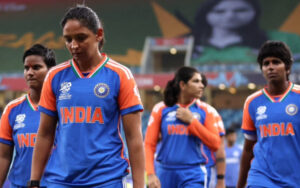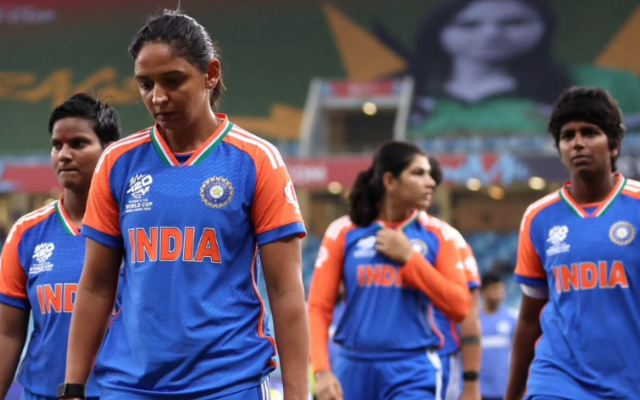
Snehasis Mukherjee in Dubai
The Indian Women’s Cricket team suffered a crushing 58-run defeat against New Zealand in their opening clash of the ICC Women’s T20 World Cup at the Dubai International Stadium. Outplayed in all three departments, India now faces serious concerns ahead of their next game against Pakistan, with fans raising questions. Here are the five key reasons why India lost to New Zealand:
1. Using Pooja Vastrakar for Just One Over
In the final practice session before the clash against New Zealand, Pooja Vastrakar was seen undergoing fitness drills, raising concerns about her availability. However, when she arrived at the stadium yesterday, she was spotted with a strap on her ankle.
Indian fans were relieved to see her in the playing XI, but she bowled only one over, leaving significant questions about the team’s selection. It’s always risky to field a player who isn’t fully fit over a healthier alternative, even if she is one of your top performers.
India took the gamble and paid the price. She bowled just one over and scored eight runs off seven balls. Ultimately, she seemed to play through a minor injury or niggle, and now all eyes are on her availability for the next game against Pakistan.
2. Same Old Fielding Mistakes
Fielding has long been a troublesome area for this team. During that same practice session, the Indian management focused on improving fielding skills. However, in this match, the same old mistakes resurfaced, particularly in ground fielding and catching.
Players like Smriti Mandhana misjudged the ball, and what could have been an easy catch ended up going for six. Sloppy ground fielding also cost India an additional 15-20 runs. When it came to catching, Indian players were often seen waiting for the ball to come to them, rather than fully committing to a forward dive to turn half-chances into catches. Even during the practice sessions, there was a noticeable lack of intent to dive forward and take difficult chances. This same hesitation was replicated during the game.
For the Latest Sports News: Click Here
3. Harmanpreet Kaur – The Captain
Harmanpreet Kaur faltered once again as skipper, particularly with her bowling changes and field placements. For instance, New Zealand’s Brooke Halliday repeatedly played sweep shots and consistently scored runs through the same region. Despite this, Harmanpreet failed to set a field to counter the tactic. New Zealand batters were targeting the straight boundaries, but the fielders were not brought finer.
Contrast this with her counterpart, New Zealand skipper Sophie Devine. Despite not coming into the game with many runs, Devine rose to the occasion when it mattered most, scoring those crucial runs. Even, her team was winless in their last 10 T20Is. She led from the front, and her strategic use of bowlers—especially holding back prime bowlers like Lea Tahuhu and Kerr for the latter stages of the game—was a masterclass in captaincy.
Devine did this because, in recent games, India’s middle order—featuring the likes of Jemimah Rodrigues, Richa Ghosh, and Deepti Sharma—has performed well and even won matches for India on several occasions. Therefore, Devine strategically held back her prime bowlers to target India’s in-form batters.
4. Top-Order Batting Woes
India won both of their warm-up matches, but fans were disappointed to see Shafali Verma and Harmanpreet Kaur fail to score runs while opening and batting at number three, respectively. Despite this, many hoped that this match would be a turning point for them.
However, they failed once again, losing three wickets within the powerplay while chasing 161. This collapse completely derailed their chase, increasing the required run rate and putting immense pressure on the remaining batters, who ultimately crumbled under the strain.

5. Lack of Application from India’s Batters
Compared to New Zealand, India’s batters were nowhere close. The White Ferns made full use of the powerplay, and despite losing two quick wickets afterwards, Kerr, Devine, and Halliday built steady partnerships that guided them to a competitive 160-run total. Devine led the charge, playing counter-attacking shots, especially against the spinners, skillfully using the crease and targeting the smaller boundary. Kerr and Halliday played the much-needed supporting roles.
In contrast, India’s batters struggled to replicate that. They faltered badly in the powerplay, putting unnecessary pressure on the remaining batters. As a result, they failed to either play aggressively or anchor the innings, eventually losing the match by 58 runs.
This loss not only cost them crucial points but also hurt their net run rate. The upcoming games against Pakistan, Sri Lanka, and Australia have become must-win for India to secure a spot in the semi-finals. All eyes will be on how quickly they can rectify their mistakes and rise to the challenge against Pakistan tomorrow.
Also Read: Devine, bowlers power New Zealand to crushing win




